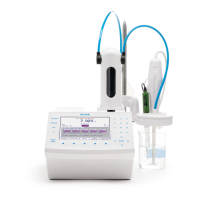1
DESCRIPTION
Method for the standardization (titer determination) of 0.1N Sodium
Hydroxide (NaOH) titrant solution against Potassium Hydrogen
Phthalate (KHP). The results are expressed in N (eq/L).
REFERENCE
AOAC Official Methods of Analysis, Official Method 936.16
ELECTRODE
• HI1131B Combination pH Electrode
• HI7662-T Temperature Probe
REAGENTS
• HI70456 0.1N Sodium Hydroxide (1 L)
• HI70401 Potassium Hydrogen Phthalate (20 g)
• HI70436 Deionized Water (1 gal)
ACCESSORIES
• HI70300L Storage Solution (500 mL)
• HI7071 Electrode Fill Solution (30 mL x 4)
• HI7004L pH 4.01 Buffer Solution (500 mL)
• HI7007L pH 7.01 Buffer Solution (500 mL)
• HI7010L pH 10.01 Buffer Solution (500 mL)
• HI740036P 100 mL Plastic Beaker (10 pcs)
• Analytical Balance with 0.0001 g resolution
DEVICE PREPARATION
• Connect the pH electrode and temperature probe to the titrator.
• Install a 25 mL burette filled with 0.1N sodium hydroxide
(HI70456) on pump one and verify that no air bubbles are present
in the burette or tubing. If necessary prime the burette until all the
air has been removed completely.
• Press from the main screen. Use the arrow keys
to highlight HI0001EN 0.1N Sodium Hydroxide and press
.
ELECTRODE PREPARATION
• Press from the main screen, if necessary select the
analog board and press .
• Calibrate the electrode using pH 4.01, 7.01 and 10.01 buffers.
Refer to the instruction manual for calibration procedure.
SAMPLE PREPARATION
• Crush approximately 3 grams of potassium hydrogen phthalate
(HI70401) and dry it for 2 hours at 120°C. Cool to room
temperature in a desiccator.
• Place a clean 100 mL plastic beaker on the analytical balance.
• Zero the balance.
• Carefully weigh approximately 0.20 grams of dried potassium
hydrogen phthalate into the beaker. Ensure that all of the
potassium hydrogen phthalate is on the bottom of the beaker.
• Record the exact weight of the sample once the balance has
stabilized with an accuracy of 0.0001 grams.
• Remove the beaker from the balance and add deionized water
to the 50 mL mark on the beaker.
ANALYSIS
• Place the beaker under the stirrer assembly and lower it to
immerse the pH electrode, temperature probe and stirrer. Ensure
that the reference junction of the pH electrode is 5 to 6 mm
below the surface. If necessary add extra deionized water.
Note: The dispensing tip should be slightly submerged in the
sample.
• Press . You will be prompted to enter the weight of the
analyte (weight of potassium hydrogen phthalate). Use the
numeric keypad to enter the exact weight and press to
start the analysis.
Note: Ensure that the potassium hydrogen phthalate dissolves
completely during the pre-titration stir time. Erroneous results
may occur if the sample does not dissolve completely prior to
titration. If necessary the pre-titration stir time can be increased.
• At the end of the titration, after detection of the equivalence
point, “Titration Completed” will appear with the result. The
result is expressed in N (eq/L) of sodium hydroxide.
• Remove the pH electrode, temperature probe and stirrer from the
sample and rinse them thoroughly with deionized water.
• Record the result.
Note: For improved accuracy, repeat this procedure a minimum
of three times and calculate the average value.
For methods utilizing 0.1N sodium hydroxide titrant solution,
follow the steps below to enter the titer/standardized value.
• Select the method utilizing 0.1N sodium hydroxide.
• Press from the main screen.
• Using the arrow keys, highlight Titrant Conc. and press
.
• Use the numeric keypad to enter the standardized (titer) value
of the titrant then press .
• Press to exit the View/Modify Method screen. Use
the arrow keys to highlight Save Method and press .
0.1N SODIUM HYDROXIDE TITRANT CONCENTRATION
0.1N SODIUM HYDROXIDE TITRANT CONCENTRATION
METHOD ID: HI0001EN

